Folio lists
About Lists
This feature allows you to create lists of latest acquisitions, reading lists and so on and make them available in Folio. These will be displayed in the Lists menu:
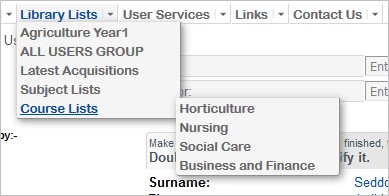
If you want to group your lists, as in the above example you will need to group your lists into "container" Folders in OLIB Web.
In the above example in Folio, Course Lists is one of the container Folders.
In OLIB Web, the container Folder Course Lists contains several Folders of titles - Business and Finance, Social Care and so on.
Folio can display the Title contents of these Folders. This looks like a standard Folio title hitlist display, but instead it contains the titles within your OLIB Web folder:
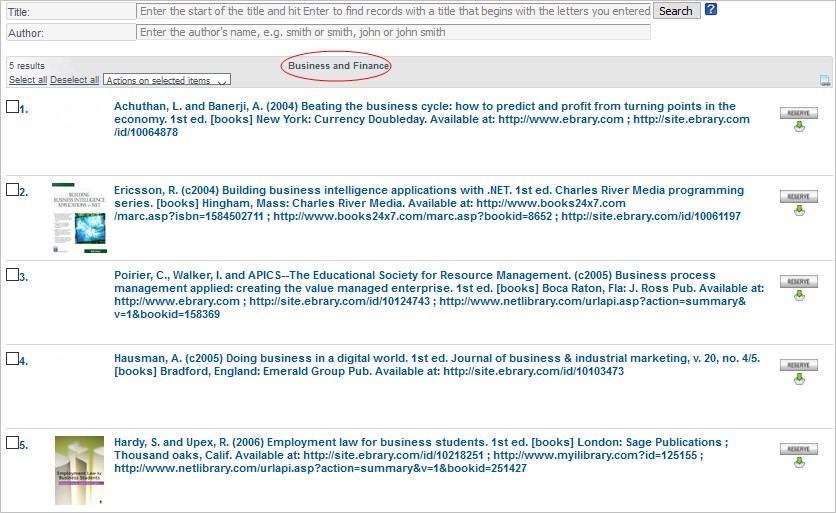
This allows you to make course reading lists and latest acquisitions lists easily available through Folio.
The lists can be restricted to specific groups of users or made available to all.
Who can access Lists?
- Users who are using the specified SSi(s)
- Users who are registered on specified courses
- Users who are registered at specified locations
- Users whose supervisor owns the list
- All users
Overview
- Create course / reading lists folder
- Create container folder
- Configure lists on the Folio menu bar
Example: create course lists / reading lists
First you create a list of the books, articles and so on that should be in the Course / Reading List. To do this you create a Folder of title records in the Folders domain:
- Go to Searches> Folders.
- Create a new Folder with a Folder Type of Titles. Enter a meaningful Folder Name to identify it, e.g. Business and Finance. The Owner of the folder defaults to you as the logged in user. Change if required.
- Search and select the title records into the Contents field.
- Save the details.
- Repeat the above to create as many Folders of titles as you require - one for each course / reading list.
Example: create a container Folder that contains all the above course / reading list folders
- Go to Searches> Folders.
- Create a new Folder with a Folder Type of Folders and with a Folder Name to identify it, e.g. Course Lists. The Owner of the folder defaults to you as the logged in user. Change if required.
- Search and select the previous titles folders above (e.g. Business and Finance) into the Contents field.
- Continue to insert more titles folders into the Contents list until all courses / reading lists are present.
- Next go to the OPAC List sheet.
- Edit the Expiry Date as required. This causes the folder to be deleted at a future date (but not the titles/records in it.) If left null, the default is 5 years.
- Enter a number in OPAC List Sequence that determines the order in which the container Folder appears in Folio's "Library Lists" menu.
- For example in the Library Lists screenshot above, Course Lists is number 5 in the list.
- Using one or more of the following choices will limit who can see the list in Folio's "Library Lists" menu. Restrict who can see the folder list by using the following settings in the OPAC List sheet:
| Field | Description |
|---|---|
| For My Students? (Y/N) | Each folder has an Owner. Students can see this folder if the folder is owned by their supervisor. (The user recorded as their supervisor in their user record). |
| Public OPAC Interface Numbers | Optionally, if you have more than one Folio interface, enter the interface number(s) separated by a comma. If set to "1" (your Folio interface number), this Folder will be visible to all users. |
| OPAC List Courses | Restrict this course to users registered on these Courses. (All Users with that Course specified in their User record). |
| OPAC List Locations | Restrict this course to users registered at these Locations. (All Users with that Location specified in the User record). |
| Parent Folders | For information, OLIB displays any "parent" (container) folder if present. |
| OPAC Lists Groups | Prior to OLIB 9 SP13, Lists had to be granted permission for viewing by an OPAC User Group. OLIB displays these here for reference. In addition to the above settings, you can also limit viewing permission of this Folder by using Permissions in OLIB Web to Share the folder to specific Users / User Groups. This field displays those users for which this folder has been granted permissions. |
Configure lists on the menu bar
In OLIB Web, create a menu option for the Lists:
- Go to OPAC> Configuration Settings.
- From Other Searches, use Folio Configuration Settings by Setting and search for menu_options.
- Open the menu_options setting for catListsMenu.
- In Value2 you can enter a generic name for this menu item, e.g. Reading Lists, Library Lists. Encase in double quotes.
- Set Include=Yes.
The new menu item will be available when you next log in to Folio.
Lists display in Folio
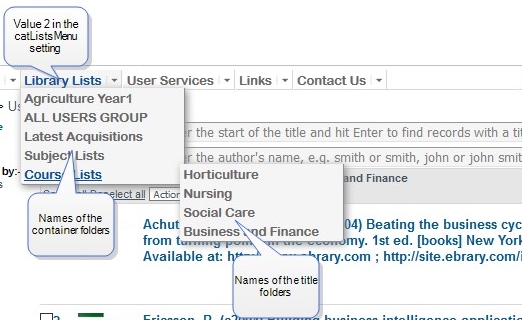
- The Lists menu displays along the top of the Folio screen: Library Lists.
- The drop-down menu contains the names of the container folders: Latest Acquisitions, Subject Lists, Course Lists.
- The sub-menu for each container a list of the (courses) title folders: Nursing, Social Care...
- If more levels are desired, container folders can themselves contain container folders. The last level container folder must contain titles folders in order for results to be accessible.
Tip: consider the usability for your end users when adding multiple levels of folders in this way.
This configuration takes effect when you next reload Folio.
Allow end users to create Lists
It is possible to configure Folio to allow end users to save their Basket as a List.
Using in Folio
The logged in user clicks on the Basket icon at the top of the screen as normal, to open the items in it.
 In the list of Basket items, they select “Save Basket List” from the Actions drop down
In the list of Basket items, they select “Save Basket List” from the Actions drop down
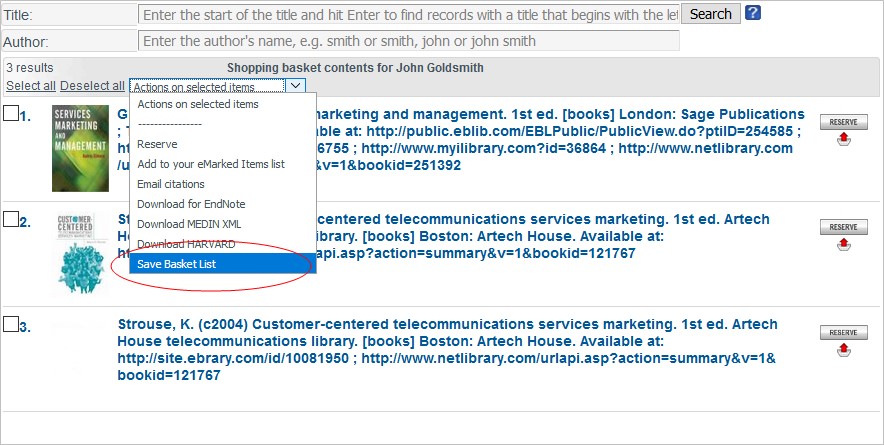
Folio prompts the user to enter a name for the List and to save it.
The new Lists are visible to the user immediately in the “Library Lists” menu:
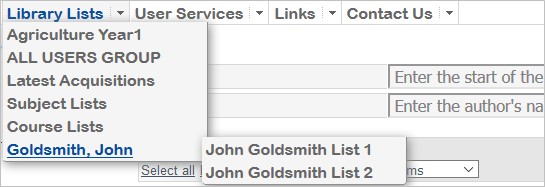
In OLIB Web, the new saved list is added to the first container Folder owned by that user. If a container folder does not already exist, then Folio creates it. The newly saved Basket List folder is added to it as a “contents” Folder.
Configuration in OLIB Web
To achieve this, two settings are required:
- A new action_array setting in Folio configuration
- Set the Can Save Lists? field in User Categories
Create new action_array setting
- Go to OPAC> Configuration Settings by Setting.
- Search for action_array.
- Existing actions from g_titles_hitlist are displayed:
| Config Setting ID | Interface | Config Block | Setting | Value | Sequence 1 | Sequence 2 | Include? |
|---|---|---|---|---|---|---|---|
| 603011 | 1 | g_title_hitlist | action_array | "Reserve" | 10 | 1 | Y |
| 603013 | 1 | g_title_hitlist | action_array | "Add to your eMarked Items list" | 10 | 2 | Y |
| 603015 | 1 | g_title_hitlist | action_array | "Add to a List" | 10 | 3 | Y |
| 603017 | 1 | g_title_hitlist | action_array | "Display in ISBD" | 10 | 4 | Y |
| 603021 | 1 | g_title_hitlist | action_array | "Download for EndNote" | 10 | 5 | Y |
| 1000053 | 1 | g_title_hitlist | action_array | "Download HARVARD" | 10 | 6 | Y |
| 603044 | 1 | g_title_hitlist | action_array | "Save search" | 10 | 7 | Y |
| 603019 | 1 | g_title_hitlist | action_array | "Email citations" | 10 | 8 | Y |
- Click New Record to create a “Save Basket List” action as follows.
| Config Block | g_title_hitlist | Description |
|---|---|---|
| Setting | action_array | |
| Value | “Save Basket List” | |
| Value 2 | 8 | |
| Sequence 1 | 10 | Should match the Sequence 1 value of the sibling action_array items |
| Sequence 2 | 9 | Set to wherever you want this action to appear in the drop down list (in the above example array, 9 would add the action to the end of the list). |
Set Can Save Lists? for relevant User Categories
- Go to User Management Reference Data> User Categories.
- Search for the user categories whose linked users should be able to create Lists.
- Set Can Save Lists? = Yes.
This configuration takes effect in Folio immediately.
